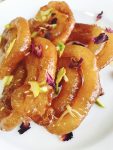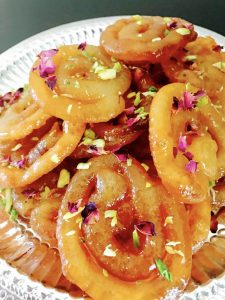Jalebi’s are the tempting all-occasion spiral confections enjoyed all over in India. They are enjoyed hot out of the kadhai (frying pan) in winter mornings and also at any other time of the day either hot or cold. They are made by frying dough, much like funnel cakes. The dough is fermented overnight using yogurt cultures.
Rajashree’s Jalebis
Jalebi was one of the recipes we had never tried ourselves. We had read many recipes and were just not sure that all of them work because we are quite particular about how we like the jalebi’s. So when we had our sister in law over we urged her to teach us to make jalebi’s. She not only taught us but also created a fantastic batch of jalebis, half of which disappeared as they were getting made. We try to bring you this recipe as we try to include all the insights she provided.
Jalebi’s should be light
The lightness comes from a properly fermented batter. Its important mix in pro-biotic yogurt and then letting the batter rest and rise in warm environment overnight.
The other factor is the batter should not be after that point over-mixed and handled delicately. When frying the small air bubbles in fermented batter expand from the heat and create a light jalebi, hence the temperature of frying is important. This expansion happens early on when the dough hits the oil and the temperature should be high enough that the dough expands immediately and rises.
Our love for crispy Jalebi’s
We asked rajashree what really makes the jalebi’s crispy. She showed us what.
Its the fine semolina flour that helps make the fried jalebi get a crispy crust. We wanted to test the jalebis when they came out of the pan and we tried knocking them with our nails and we could hear a hard knock. This was because of the semolina that allows the jalebis to get this crispy crust.
We add also a little bit of raw oil to the batter just before frying, and this also helps to get the crispy jalebis.
The other part is the frying temperature. We mentioned how it needs to be hot enough to make the jalebis float, but after that it needs to be not so hot that the jalebis turn dark brown within seconds. They need to get to golden brown slowly frying away as moisture is drawn and leaves the jalebis to be crispy. Here the tip would be to use a large pan to use the volume of oil to keep the temperature more stable. We used a thermometer to measure the temperature and it was between 350-360 F. We would recommend to start here then adjust up or down after observing the first batch.
The last bit is that the sugar syrup that the jalebis are dipped in should be dense and warm. When the jalebis then are taken out and allowed to cool the sugar syrup too cools and condenses to give it that slight glass like shine and crispiness.
About the color of Jalebis
The dark orange jalebis you see on street stalls and sweet shops many times have food color added to them. We dont like to use much food coloring. Here Rajashree lets the saffron do the work. Other color comes from her precise frying to golden hues. Watch the white batter in video transformed to uniform gold! The last touch is from the shininess of sugar syrup as it cools. We add some lovely rose petals and peeled pistachio slices for flavor and aesthetics.
Equipment
We are at the start of spring in wisconsin and our temperatures are home are 70 F at best. To counter this we created a high volume water bath of 110 F and left the batter in glass mason jars in this water bath to overall give the batter a warm environment. You might not need to do this in warmer region or warmer times of the year.
We recommend to use a squeeze bottle at home although sweet shop artisan use a cloth with a hole which has reinforced stitching. The tip of squeeze bottle can be adjusted to provide a correct opening.
For the frying pan choose one that gives volume and depth for the oil. There are small single jalebi at a time pans available as well, just make sure they are deep enough to accommodate the thickness of your jalebi.
For cooling the jalebi’s is equally important we let them cool on cooling wire racks over a baking sheet pan.
Variations to try
We made a batch of fairly thick spirals, one of the jalebi’s we love have very thin thickness of batter squeezed out into the frying pan. You should vary this based on your preference.
In the syrup Rajashree added a few drops of lime juice every now and then. This helps cut the single dimensional sweetness of the sugar syrup. It would be also okay to add just a pinch of salt to batter or to syrup as is done many times with sweet recipes, although this is not part of Rajashree’s classic recipe.
For frying and draining rajashree used a kabab skewer which actually works really well to turn the jalebi but also to drain them of the oil.
Also the syrup can be spiked with local honey from different flowers to add some unique flavors. You can also flavor the syrup with some cardamom.
We also have not tried making the jalebis with flours other than maida (AP Flour), but do think that quinoa flour could work. We also wonder how addition of some amaranth (rajgira) would work.
Other variations can be in the nut and flowers used for garnishing. Almond sliver, marigold are the ones that come to mind.

Jalebi
- Total Time: 13 hours
- Yield: Serves 4
Ingredients
- 2 cups fine semolina flour
- 1 cup maida/ all purpose flour
- 2 Tbsp Besan (chic pea flour)
- 2 to 3 Tbsp active culture yogurt thinned with 1 Tbsp water (use 2 Tbsp for sour yogurt, 3 for sweet yogurt)
- 1 to 2 cups water
- 2 Tbsp Raw vegetable oil
- 3 cups sugar
- water enough to just submerge sugar in pan
- 0.5 tsp saffron strands (optional)
- 0.5 tsp lime juice
- 6 raw pistachio
- 1 tsp rose petals (optional)
- Oil for frying
Instructions
- mix semolina flour, all purpose flour, chic pea flour, yogurt mixture and gradually add water mixing carefully to make sure no lumps are formed (this step can be done in a stand mixer)
- This should form a pancake like batter, on thicker side, so gradually add water as you mix
- Place this batter undisturbed and covered in a warm spot in a covered glass jar or bowl and let it ferment overnight
- When you smell this next day it should smell a bit yeasty or sour
- Set a deep cast iron pan on medium high heat with oil for frying and get it hot enough to reach 350-360F adjusting temperature accordingly to then keep it there
- Heat a pan with the sugar and add saffron strands and water just barely enough to cover
- Melt the sugar till it is hot and boiling then turn heat to very low just keeping this mixture warm
- gently fold in the 2 Tbsp raw oil into the fermented batter and put this fermented batter in squeeze bottles and start by squeezing out spirals in the 360 F oil
- The batter should rise up to the top letting you know oil is hot enough and after that it should slowly turn to golden brown and not instantly letting you know that the temperature is not too high either. Adjust using this test jalebi for further jalebis.
- Patiently fry jalebis, turning them making sure they get uniformly fried. When the jalebis are fried crisp transfer them to the warm sugar syrup with a few drops of lime juice mixed in every now and then into the syrup
- Dunk them to let them absorb the syrup and then as you fry the next batch of jalebi’s remove the ones soaking out to cool and drain on a wire rack with a pan underneath
- Soak pistachios for minute in a few tablespoons of boiling water, drain and rub ina towel to peel the skin off. Make thin slices.
- Garnish with some rose petals and pistachios while the jalebis are still cooling off making this stick to the sticky syrup
- When all jalebi’s are done serve in a platter, warm and garnished with remaining rose petals and pistachios
- Prep Time: 12 hours
- Cook Time: 60 mins


